Procurement & Contract Management Report: Southern Han vs Lewence Case
VerifiedAdded on 2020/05/11
|16
|4463
|260
Report
AI Summary
This report analyzes the complex contract dispute between Southern Han and Lewence, which involved a $15.6 million construction project in Sydney, Australia. The dispute arose from alleged contract breaches by Lewence, leading Southern Han to terminate the contract. Lewence subsequently filed a payment claim, triggering a series of legal proceedings, including adjudication, Supreme Court, Court of Appeal, and High Court of Australia decisions. The core issue revolved around the validity of a payment claim and the application of the AS 4000 contract and the Building and Construction Industry Security of Payment Act. The High Court ultimately ruled in favor of Southern Han, emphasizing the importance of understanding contract terms and conditions. The report details the project's procurement system, the contractual clauses involved, and the chronological history of the dispute, including the various dispute resolution approaches and their outcomes. It highlights the lessons learned and provides personal reflections and recommendations for preventing similar disputes in the future, emphasizing the need for clear contract language and adherence to relevant legislation.
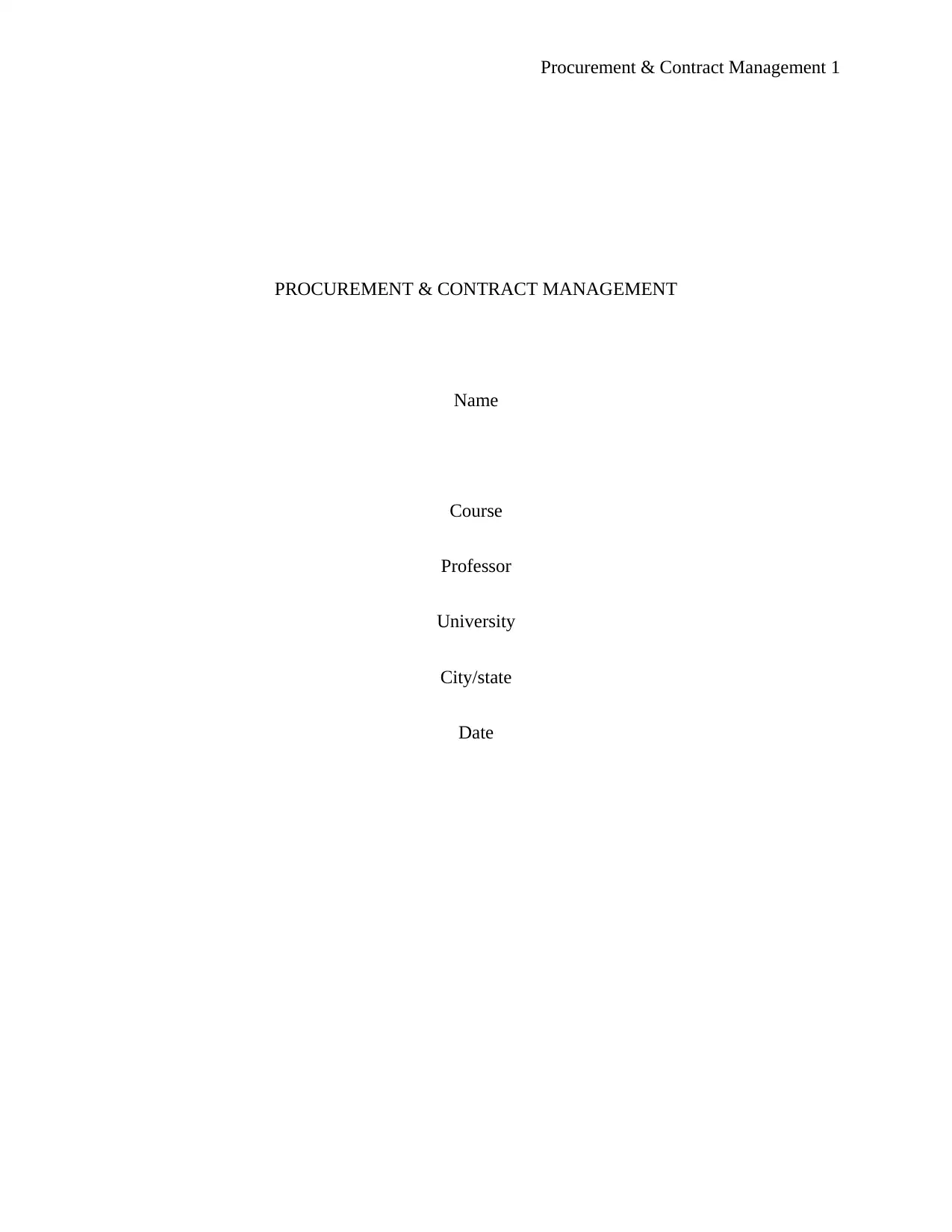
Procurement & Contract Management 1
PROCUREMENT & CONTRACT MANAGEMENT
Name
Course
Professor
University
City/state
Date
PROCUREMENT & CONTRACT MANAGEMENT
Name
Course
Professor
University
City/state
Date
Paraphrase This Document
Need a fresh take? Get an instant paraphrase of this document with our AI Paraphraser
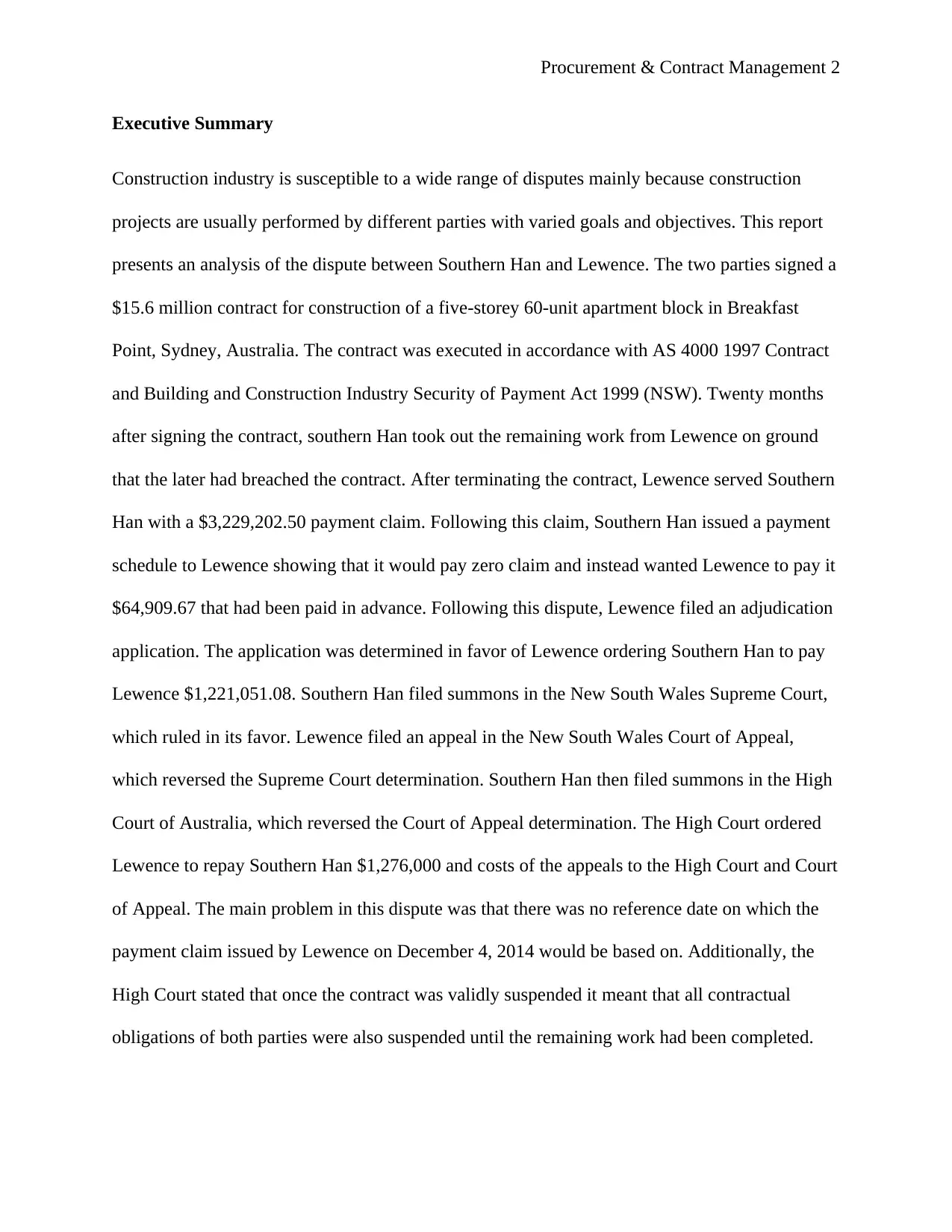
Procurement & Contract Management 2
Executive Summary
Construction industry is susceptible to a wide range of disputes mainly because construction
projects are usually performed by different parties with varied goals and objectives. This report
presents an analysis of the dispute between Southern Han and Lewence. The two parties signed a
$15.6 million contract for construction of a five-storey 60-unit apartment block in Breakfast
Point, Sydney, Australia. The contract was executed in accordance with AS 4000 1997 Contract
and Building and Construction Industry Security of Payment Act 1999 (NSW). Twenty months
after signing the contract, southern Han took out the remaining work from Lewence on ground
that the later had breached the contract. After terminating the contract, Lewence served Southern
Han with a $3,229,202.50 payment claim. Following this claim, Southern Han issued a payment
schedule to Lewence showing that it would pay zero claim and instead wanted Lewence to pay it
$64,909.67 that had been paid in advance. Following this dispute, Lewence filed an adjudication
application. The application was determined in favor of Lewence ordering Southern Han to pay
Lewence $1,221,051.08. Southern Han filed summons in the New South Wales Supreme Court,
which ruled in its favor. Lewence filed an appeal in the New South Wales Court of Appeal,
which reversed the Supreme Court determination. Southern Han then filed summons in the High
Court of Australia, which reversed the Court of Appeal determination. The High Court ordered
Lewence to repay Southern Han $1,276,000 and costs of the appeals to the High Court and Court
of Appeal. The main problem in this dispute was that there was no reference date on which the
payment claim issued by Lewence on December 4, 2014 would be based on. Additionally, the
High Court stated that once the contract was validly suspended it meant that all contractual
obligations of both parties were also suspended until the remaining work had been completed.
Executive Summary
Construction industry is susceptible to a wide range of disputes mainly because construction
projects are usually performed by different parties with varied goals and objectives. This report
presents an analysis of the dispute between Southern Han and Lewence. The two parties signed a
$15.6 million contract for construction of a five-storey 60-unit apartment block in Breakfast
Point, Sydney, Australia. The contract was executed in accordance with AS 4000 1997 Contract
and Building and Construction Industry Security of Payment Act 1999 (NSW). Twenty months
after signing the contract, southern Han took out the remaining work from Lewence on ground
that the later had breached the contract. After terminating the contract, Lewence served Southern
Han with a $3,229,202.50 payment claim. Following this claim, Southern Han issued a payment
schedule to Lewence showing that it would pay zero claim and instead wanted Lewence to pay it
$64,909.67 that had been paid in advance. Following this dispute, Lewence filed an adjudication
application. The application was determined in favor of Lewence ordering Southern Han to pay
Lewence $1,221,051.08. Southern Han filed summons in the New South Wales Supreme Court,
which ruled in its favor. Lewence filed an appeal in the New South Wales Court of Appeal,
which reversed the Supreme Court determination. Southern Han then filed summons in the High
Court of Australia, which reversed the Court of Appeal determination. The High Court ordered
Lewence to repay Southern Han $1,276,000 and costs of the appeals to the High Court and Court
of Appeal. The main problem in this dispute was that there was no reference date on which the
payment claim issued by Lewence on December 4, 2014 would be based on. Additionally, the
High Court stated that once the contract was validly suspended it meant that all contractual
obligations of both parties were also suspended until the remaining work had been completed.

Procurement & Contract Management 3
This dispute emphasizes the importance of reading and understanding contract terms and
conditions, and applicable laws and legislations.
This dispute emphasizes the importance of reading and understanding contract terms and
conditions, and applicable laws and legislations.
⊘ This is a preview!⊘
Do you want full access?
Subscribe today to unlock all pages.

Trusted by 1+ million students worldwide
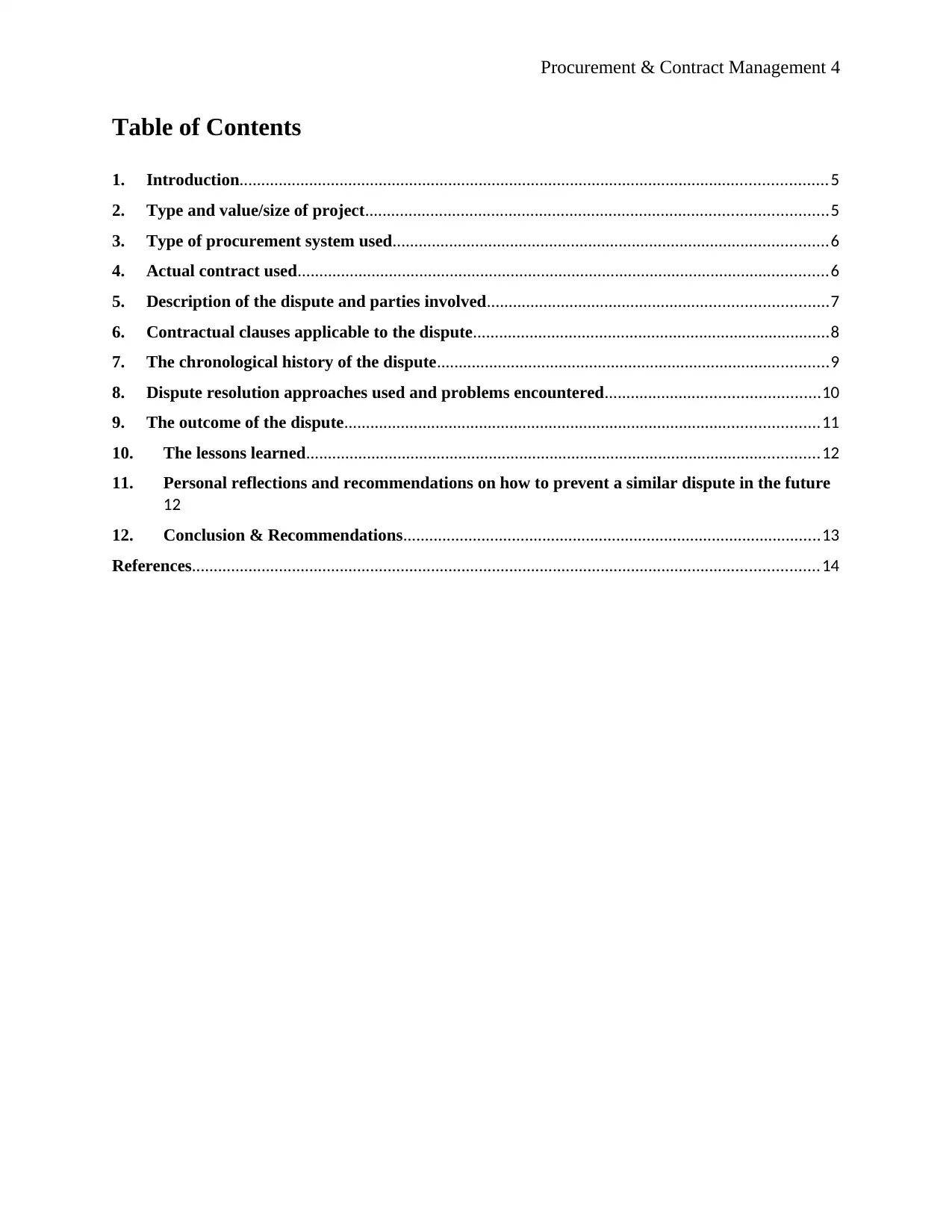
Procurement & Contract Management 4
Table of Contents
1. Introduction.......................................................................................................................................5
2. Type and value/size of project..........................................................................................................5
3. Type of procurement system used....................................................................................................6
4. Actual contract used..........................................................................................................................6
5. Description of the dispute and parties involved..............................................................................7
6. Contractual clauses applicable to the dispute..................................................................................8
7. The chronological history of the dispute..........................................................................................9
8. Dispute resolution approaches used and problems encountered.................................................10
9. The outcome of the dispute.............................................................................................................11
10. The lessons learned......................................................................................................................12
11. Personal reflections and recommendations on how to prevent a similar dispute in the future
12
12. Conclusion & Recommendations................................................................................................13
References................................................................................................................................................14
Table of Contents
1. Introduction.......................................................................................................................................5
2. Type and value/size of project..........................................................................................................5
3. Type of procurement system used....................................................................................................6
4. Actual contract used..........................................................................................................................6
5. Description of the dispute and parties involved..............................................................................7
6. Contractual clauses applicable to the dispute..................................................................................8
7. The chronological history of the dispute..........................................................................................9
8. Dispute resolution approaches used and problems encountered.................................................10
9. The outcome of the dispute.............................................................................................................11
10. The lessons learned......................................................................................................................12
11. Personal reflections and recommendations on how to prevent a similar dispute in the future
12
12. Conclusion & Recommendations................................................................................................13
References................................................................................................................................................14
Paraphrase This Document
Need a fresh take? Get an instant paraphrase of this document with our AI Paraphraser
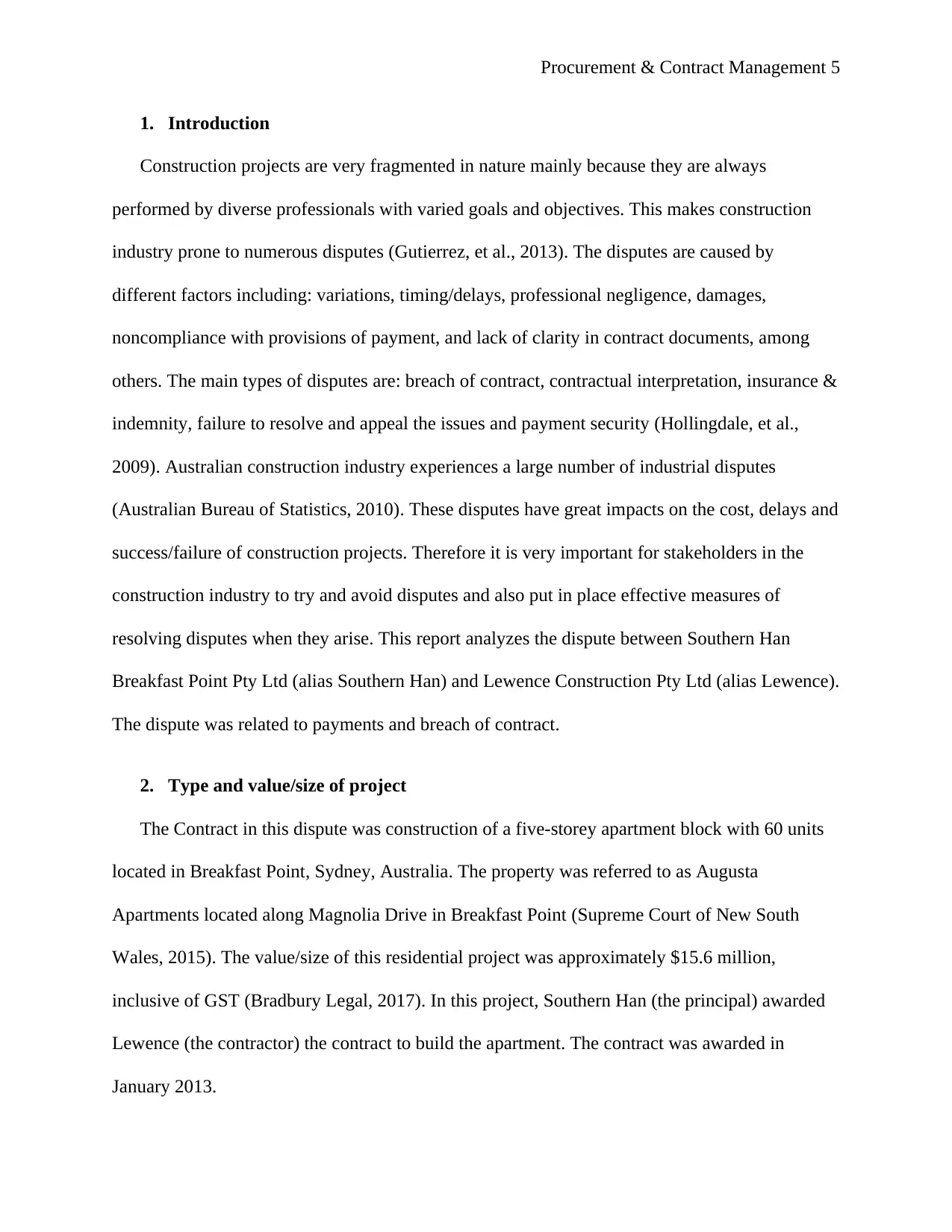
Procurement & Contract Management 5
1. Introduction
Construction projects are very fragmented in nature mainly because they are always
performed by diverse professionals with varied goals and objectives. This makes construction
industry prone to numerous disputes (Gutierrez, et al., 2013). The disputes are caused by
different factors including: variations, timing/delays, professional negligence, damages,
noncompliance with provisions of payment, and lack of clarity in contract documents, among
others. The main types of disputes are: breach of contract, contractual interpretation, insurance &
indemnity, failure to resolve and appeal the issues and payment security (Hollingdale, et al.,
2009). Australian construction industry experiences a large number of industrial disputes
(Australian Bureau of Statistics, 2010). These disputes have great impacts on the cost, delays and
success/failure of construction projects. Therefore it is very important for stakeholders in the
construction industry to try and avoid disputes and also put in place effective measures of
resolving disputes when they arise. This report analyzes the dispute between Southern Han
Breakfast Point Pty Ltd (alias Southern Han) and Lewence Construction Pty Ltd (alias Lewence).
The dispute was related to payments and breach of contract.
2. Type and value/size of project
The Contract in this dispute was construction of a five-storey apartment block with 60 units
located in Breakfast Point, Sydney, Australia. The property was referred to as Augusta
Apartments located along Magnolia Drive in Breakfast Point (Supreme Court of New South
Wales, 2015). The value/size of this residential project was approximately $15.6 million,
inclusive of GST (Bradbury Legal, 2017). In this project, Southern Han (the principal) awarded
Lewence (the contractor) the contract to build the apartment. The contract was awarded in
January 2013.
1. Introduction
Construction projects are very fragmented in nature mainly because they are always
performed by diverse professionals with varied goals and objectives. This makes construction
industry prone to numerous disputes (Gutierrez, et al., 2013). The disputes are caused by
different factors including: variations, timing/delays, professional negligence, damages,
noncompliance with provisions of payment, and lack of clarity in contract documents, among
others. The main types of disputes are: breach of contract, contractual interpretation, insurance &
indemnity, failure to resolve and appeal the issues and payment security (Hollingdale, et al.,
2009). Australian construction industry experiences a large number of industrial disputes
(Australian Bureau of Statistics, 2010). These disputes have great impacts on the cost, delays and
success/failure of construction projects. Therefore it is very important for stakeholders in the
construction industry to try and avoid disputes and also put in place effective measures of
resolving disputes when they arise. This report analyzes the dispute between Southern Han
Breakfast Point Pty Ltd (alias Southern Han) and Lewence Construction Pty Ltd (alias Lewence).
The dispute was related to payments and breach of contract.
2. Type and value/size of project
The Contract in this dispute was construction of a five-storey apartment block with 60 units
located in Breakfast Point, Sydney, Australia. The property was referred to as Augusta
Apartments located along Magnolia Drive in Breakfast Point (Supreme Court of New South
Wales, 2015). The value/size of this residential project was approximately $15.6 million,
inclusive of GST (Bradbury Legal, 2017). In this project, Southern Han (the principal) awarded
Lewence (the contractor) the contract to build the apartment. The contract was awarded in
January 2013.
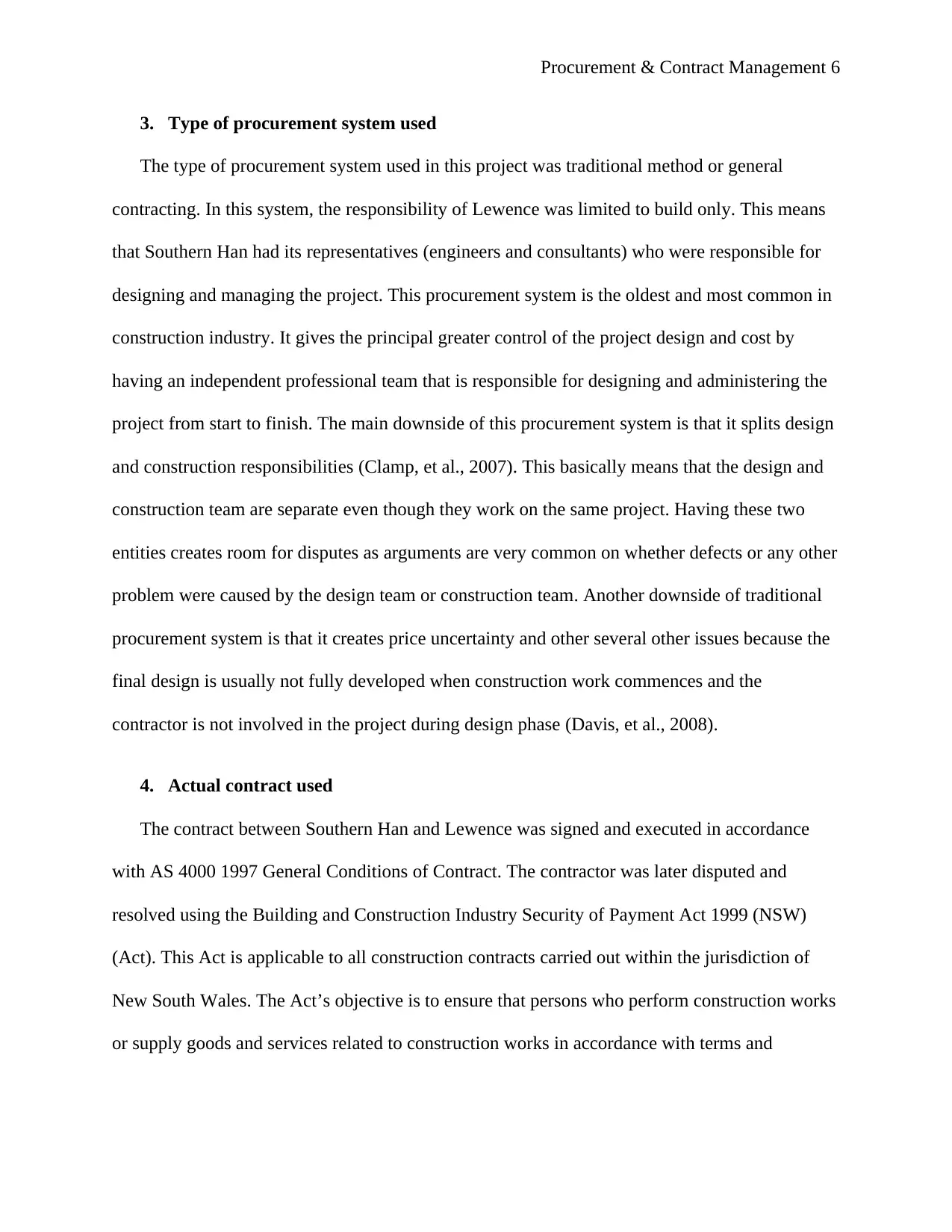
Procurement & Contract Management 6
3. Type of procurement system used
The type of procurement system used in this project was traditional method or general
contracting. In this system, the responsibility of Lewence was limited to build only. This means
that Southern Han had its representatives (engineers and consultants) who were responsible for
designing and managing the project. This procurement system is the oldest and most common in
construction industry. It gives the principal greater control of the project design and cost by
having an independent professional team that is responsible for designing and administering the
project from start to finish. The main downside of this procurement system is that it splits design
and construction responsibilities (Clamp, et al., 2007). This basically means that the design and
construction team are separate even though they work on the same project. Having these two
entities creates room for disputes as arguments are very common on whether defects or any other
problem were caused by the design team or construction team. Another downside of traditional
procurement system is that it creates price uncertainty and other several other issues because the
final design is usually not fully developed when construction work commences and the
contractor is not involved in the project during design phase (Davis, et al., 2008).
4. Actual contract used
The contract between Southern Han and Lewence was signed and executed in accordance
with AS 4000 1997 General Conditions of Contract. The contractor was later disputed and
resolved using the Building and Construction Industry Security of Payment Act 1999 (NSW)
(Act). This Act is applicable to all construction contracts carried out within the jurisdiction of
New South Wales. The Act’s objective is to ensure that persons who perform construction works
or supply goods and services related to construction works in accordance with terms and
3. Type of procurement system used
The type of procurement system used in this project was traditional method or general
contracting. In this system, the responsibility of Lewence was limited to build only. This means
that Southern Han had its representatives (engineers and consultants) who were responsible for
designing and managing the project. This procurement system is the oldest and most common in
construction industry. It gives the principal greater control of the project design and cost by
having an independent professional team that is responsible for designing and administering the
project from start to finish. The main downside of this procurement system is that it splits design
and construction responsibilities (Clamp, et al., 2007). This basically means that the design and
construction team are separate even though they work on the same project. Having these two
entities creates room for disputes as arguments are very common on whether defects or any other
problem were caused by the design team or construction team. Another downside of traditional
procurement system is that it creates price uncertainty and other several other issues because the
final design is usually not fully developed when construction work commences and the
contractor is not involved in the project during design phase (Davis, et al., 2008).
4. Actual contract used
The contract between Southern Han and Lewence was signed and executed in accordance
with AS 4000 1997 General Conditions of Contract. The contractor was later disputed and
resolved using the Building and Construction Industry Security of Payment Act 1999 (NSW)
(Act). This Act is applicable to all construction contracts carried out within the jurisdiction of
New South Wales. The Act’s objective is to ensure that persons who perform construction works
or supply goods and services related to construction works in accordance with terms and
⊘ This is a preview!⊘
Do you want full access?
Subscribe today to unlock all pages.

Trusted by 1+ million students worldwide
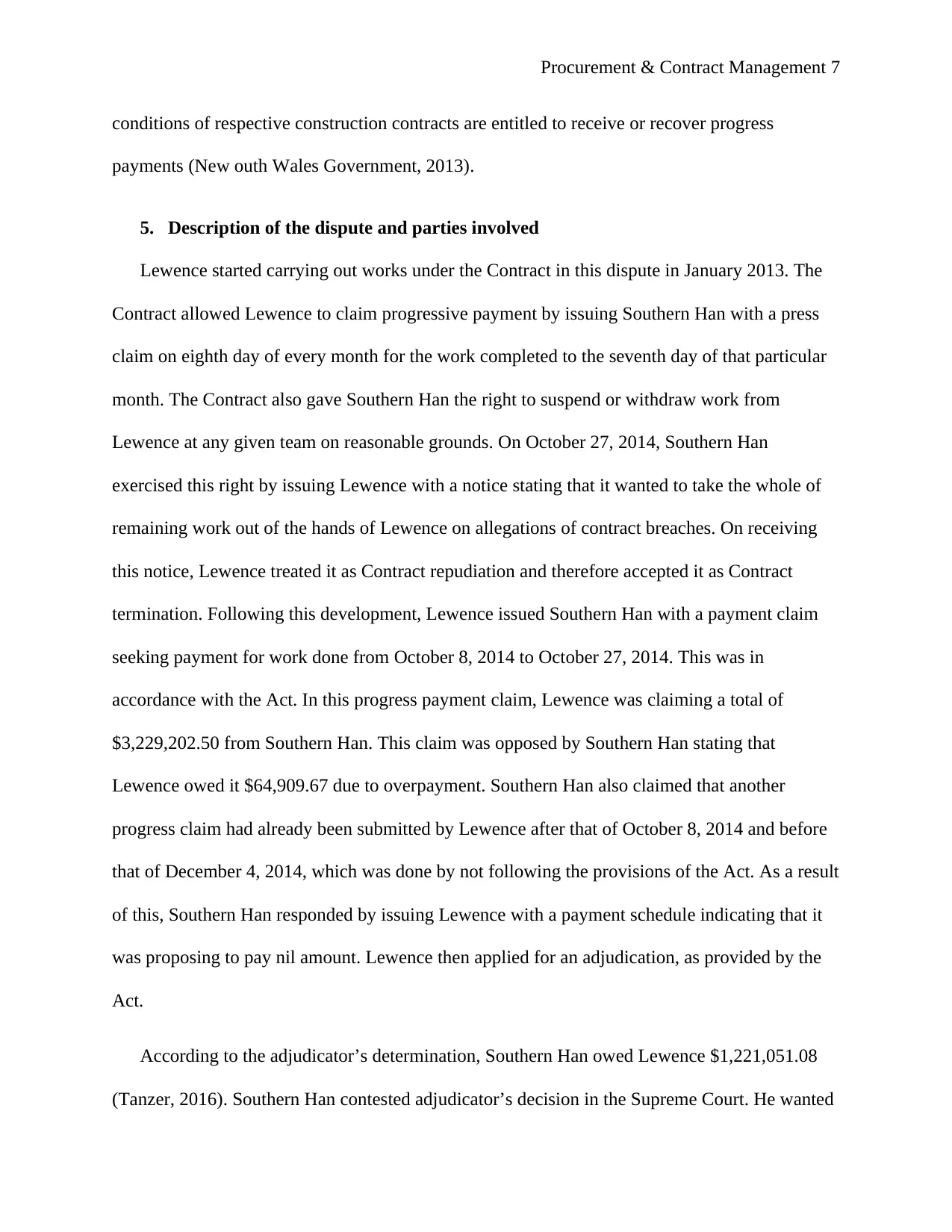
Procurement & Contract Management 7
conditions of respective construction contracts are entitled to receive or recover progress
payments (New outh Wales Government, 2013).
5. Description of the dispute and parties involved
Lewence started carrying out works under the Contract in this dispute in January 2013. The
Contract allowed Lewence to claim progressive payment by issuing Southern Han with a press
claim on eighth day of every month for the work completed to the seventh day of that particular
month. The Contract also gave Southern Han the right to suspend or withdraw work from
Lewence at any given team on reasonable grounds. On October 27, 2014, Southern Han
exercised this right by issuing Lewence with a notice stating that it wanted to take the whole of
remaining work out of the hands of Lewence on allegations of contract breaches. On receiving
this notice, Lewence treated it as Contract repudiation and therefore accepted it as Contract
termination. Following this development, Lewence issued Southern Han with a payment claim
seeking payment for work done from October 8, 2014 to October 27, 2014. This was in
accordance with the Act. In this progress payment claim, Lewence was claiming a total of
$3,229,202.50 from Southern Han. This claim was opposed by Southern Han stating that
Lewence owed it $64,909.67 due to overpayment. Southern Han also claimed that another
progress claim had already been submitted by Lewence after that of October 8, 2014 and before
that of December 4, 2014, which was done by not following the provisions of the Act. As a result
of this, Southern Han responded by issuing Lewence with a payment schedule indicating that it
was proposing to pay nil amount. Lewence then applied for an adjudication, as provided by the
Act.
According to the adjudicator’s determination, Southern Han owed Lewence $1,221,051.08
(Tanzer, 2016). Southern Han contested adjudicator’s decision in the Supreme Court. He wanted
conditions of respective construction contracts are entitled to receive or recover progress
payments (New outh Wales Government, 2013).
5. Description of the dispute and parties involved
Lewence started carrying out works under the Contract in this dispute in January 2013. The
Contract allowed Lewence to claim progressive payment by issuing Southern Han with a press
claim on eighth day of every month for the work completed to the seventh day of that particular
month. The Contract also gave Southern Han the right to suspend or withdraw work from
Lewence at any given team on reasonable grounds. On October 27, 2014, Southern Han
exercised this right by issuing Lewence with a notice stating that it wanted to take the whole of
remaining work out of the hands of Lewence on allegations of contract breaches. On receiving
this notice, Lewence treated it as Contract repudiation and therefore accepted it as Contract
termination. Following this development, Lewence issued Southern Han with a payment claim
seeking payment for work done from October 8, 2014 to October 27, 2014. This was in
accordance with the Act. In this progress payment claim, Lewence was claiming a total of
$3,229,202.50 from Southern Han. This claim was opposed by Southern Han stating that
Lewence owed it $64,909.67 due to overpayment. Southern Han also claimed that another
progress claim had already been submitted by Lewence after that of October 8, 2014 and before
that of December 4, 2014, which was done by not following the provisions of the Act. As a result
of this, Southern Han responded by issuing Lewence with a payment schedule indicating that it
was proposing to pay nil amount. Lewence then applied for an adjudication, as provided by the
Act.
According to the adjudicator’s determination, Southern Han owed Lewence $1,221,051.08
(Tanzer, 2016). Southern Han contested adjudicator’s decision in the Supreme Court. He wanted
Paraphrase This Document
Need a fresh take? Get an instant paraphrase of this document with our AI Paraphraser
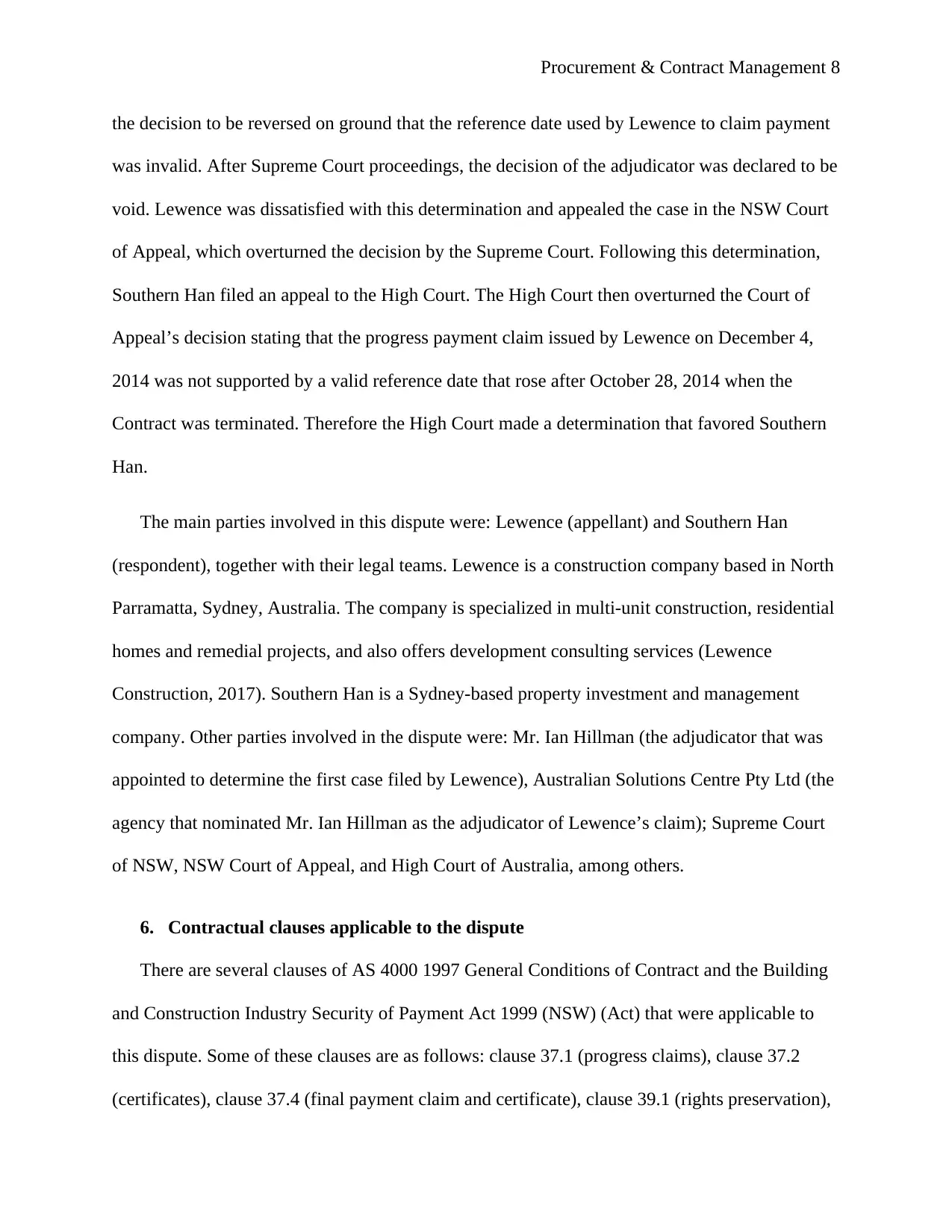
Procurement & Contract Management 8
the decision to be reversed on ground that the reference date used by Lewence to claim payment
was invalid. After Supreme Court proceedings, the decision of the adjudicator was declared to be
void. Lewence was dissatisfied with this determination and appealed the case in the NSW Court
of Appeal, which overturned the decision by the Supreme Court. Following this determination,
Southern Han filed an appeal to the High Court. The High Court then overturned the Court of
Appeal’s decision stating that the progress payment claim issued by Lewence on December 4,
2014 was not supported by a valid reference date that rose after October 28, 2014 when the
Contract was terminated. Therefore the High Court made a determination that favored Southern
Han.
The main parties involved in this dispute were: Lewence (appellant) and Southern Han
(respondent), together with their legal teams. Lewence is a construction company based in North
Parramatta, Sydney, Australia. The company is specialized in multi-unit construction, residential
homes and remedial projects, and also offers development consulting services (Lewence
Construction, 2017). Southern Han is a Sydney-based property investment and management
company. Other parties involved in the dispute were: Mr. Ian Hillman (the adjudicator that was
appointed to determine the first case filed by Lewence), Australian Solutions Centre Pty Ltd (the
agency that nominated Mr. Ian Hillman as the adjudicator of Lewence’s claim); Supreme Court
of NSW, NSW Court of Appeal, and High Court of Australia, among others.
6. Contractual clauses applicable to the dispute
There are several clauses of AS 4000 1997 General Conditions of Contract and the Building
and Construction Industry Security of Payment Act 1999 (NSW) (Act) that were applicable to
this dispute. Some of these clauses are as follows: clause 37.1 (progress claims), clause 37.2
(certificates), clause 37.4 (final payment claim and certificate), clause 39.1 (rights preservation),
the decision to be reversed on ground that the reference date used by Lewence to claim payment
was invalid. After Supreme Court proceedings, the decision of the adjudicator was declared to be
void. Lewence was dissatisfied with this determination and appealed the case in the NSW Court
of Appeal, which overturned the decision by the Supreme Court. Following this determination,
Southern Han filed an appeal to the High Court. The High Court then overturned the Court of
Appeal’s decision stating that the progress payment claim issued by Lewence on December 4,
2014 was not supported by a valid reference date that rose after October 28, 2014 when the
Contract was terminated. Therefore the High Court made a determination that favored Southern
Han.
The main parties involved in this dispute were: Lewence (appellant) and Southern Han
(respondent), together with their legal teams. Lewence is a construction company based in North
Parramatta, Sydney, Australia. The company is specialized in multi-unit construction, residential
homes and remedial projects, and also offers development consulting services (Lewence
Construction, 2017). Southern Han is a Sydney-based property investment and management
company. Other parties involved in the dispute were: Mr. Ian Hillman (the adjudicator that was
appointed to determine the first case filed by Lewence), Australian Solutions Centre Pty Ltd (the
agency that nominated Mr. Ian Hillman as the adjudicator of Lewence’s claim); Supreme Court
of NSW, NSW Court of Appeal, and High Court of Australia, among others.
6. Contractual clauses applicable to the dispute
There are several clauses of AS 4000 1997 General Conditions of Contract and the Building
and Construction Industry Security of Payment Act 1999 (NSW) (Act) that were applicable to
this dispute. Some of these clauses are as follows: clause 37.1 (progress claims), clause 37.2
(certificates), clause 37.4 (final payment claim and certificate), clause 39.1 (rights preservation),
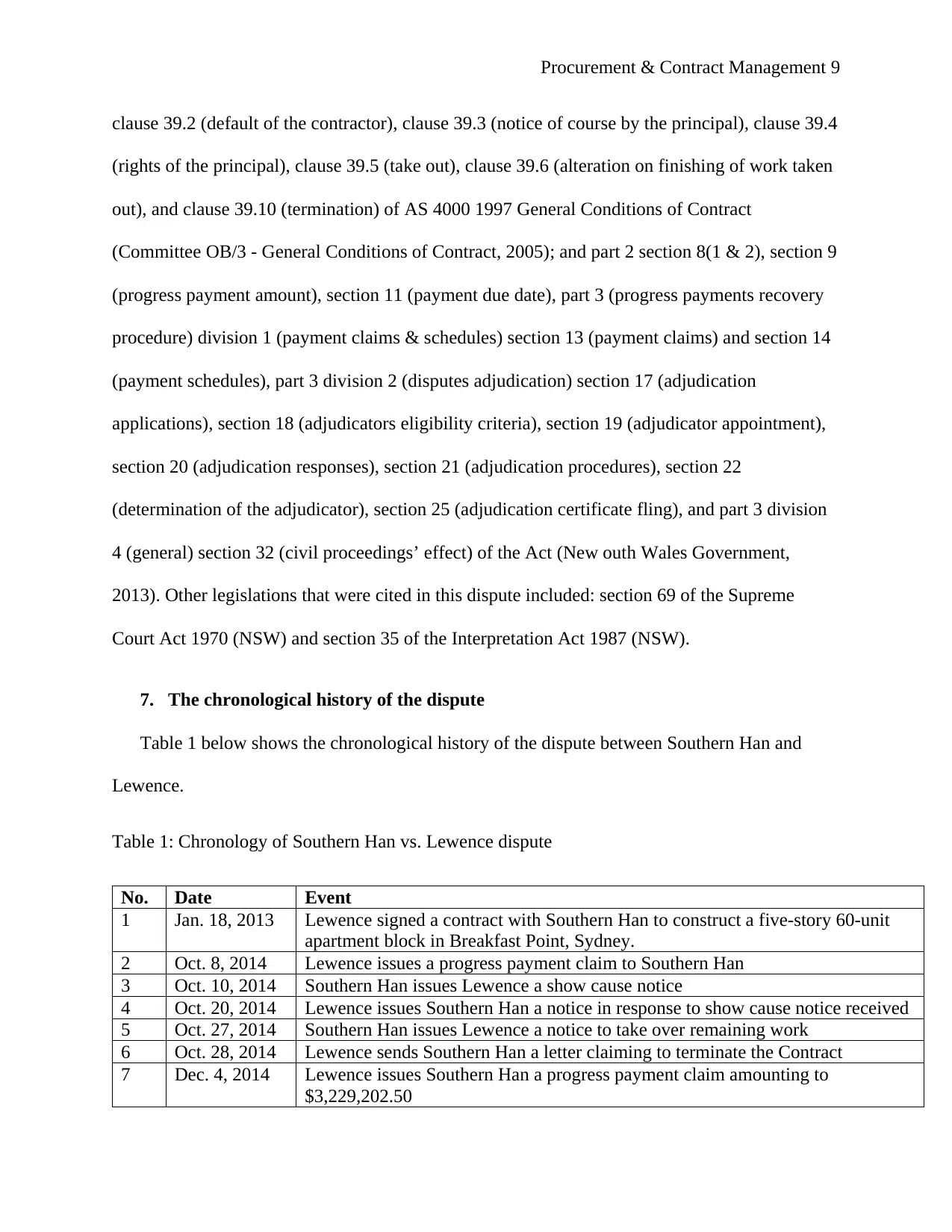
Procurement & Contract Management 9
clause 39.2 (default of the contractor), clause 39.3 (notice of course by the principal), clause 39.4
(rights of the principal), clause 39.5 (take out), clause 39.6 (alteration on finishing of work taken
out), and clause 39.10 (termination) of AS 4000 1997 General Conditions of Contract
(Committee OB/3 - General Conditions of Contract, 2005); and part 2 section 8(1 & 2), section 9
(progress payment amount), section 11 (payment due date), part 3 (progress payments recovery
procedure) division 1 (payment claims & schedules) section 13 (payment claims) and section 14
(payment schedules), part 3 division 2 (disputes adjudication) section 17 (adjudication
applications), section 18 (adjudicators eligibility criteria), section 19 (adjudicator appointment),
section 20 (adjudication responses), section 21 (adjudication procedures), section 22
(determination of the adjudicator), section 25 (adjudication certificate fling), and part 3 division
4 (general) section 32 (civil proceedings’ effect) of the Act (New outh Wales Government,
2013). Other legislations that were cited in this dispute included: section 69 of the Supreme
Court Act 1970 (NSW) and section 35 of the Interpretation Act 1987 (NSW).
7. The chronological history of the dispute
Table 1 below shows the chronological history of the dispute between Southern Han and
Lewence.
Table 1: Chronology of Southern Han vs. Lewence dispute
No. Date Event
1 Jan. 18, 2013 Lewence signed a contract with Southern Han to construct a five-story 60-unit
apartment block in Breakfast Point, Sydney.
2 Oct. 8, 2014 Lewence issues a progress payment claim to Southern Han
3 Oct. 10, 2014 Southern Han issues Lewence a show cause notice
4 Oct. 20, 2014 Lewence issues Southern Han a notice in response to show cause notice received
5 Oct. 27, 2014 Southern Han issues Lewence a notice to take over remaining work
6 Oct. 28, 2014 Lewence sends Southern Han a letter claiming to terminate the Contract
7 Dec. 4, 2014 Lewence issues Southern Han a progress payment claim amounting to
$3,229,202.50
clause 39.2 (default of the contractor), clause 39.3 (notice of course by the principal), clause 39.4
(rights of the principal), clause 39.5 (take out), clause 39.6 (alteration on finishing of work taken
out), and clause 39.10 (termination) of AS 4000 1997 General Conditions of Contract
(Committee OB/3 - General Conditions of Contract, 2005); and part 2 section 8(1 & 2), section 9
(progress payment amount), section 11 (payment due date), part 3 (progress payments recovery
procedure) division 1 (payment claims & schedules) section 13 (payment claims) and section 14
(payment schedules), part 3 division 2 (disputes adjudication) section 17 (adjudication
applications), section 18 (adjudicators eligibility criteria), section 19 (adjudicator appointment),
section 20 (adjudication responses), section 21 (adjudication procedures), section 22
(determination of the adjudicator), section 25 (adjudication certificate fling), and part 3 division
4 (general) section 32 (civil proceedings’ effect) of the Act (New outh Wales Government,
2013). Other legislations that were cited in this dispute included: section 69 of the Supreme
Court Act 1970 (NSW) and section 35 of the Interpretation Act 1987 (NSW).
7. The chronological history of the dispute
Table 1 below shows the chronological history of the dispute between Southern Han and
Lewence.
Table 1: Chronology of Southern Han vs. Lewence dispute
No. Date Event
1 Jan. 18, 2013 Lewence signed a contract with Southern Han to construct a five-story 60-unit
apartment block in Breakfast Point, Sydney.
2 Oct. 8, 2014 Lewence issues a progress payment claim to Southern Han
3 Oct. 10, 2014 Southern Han issues Lewence a show cause notice
4 Oct. 20, 2014 Lewence issues Southern Han a notice in response to show cause notice received
5 Oct. 27, 2014 Southern Han issues Lewence a notice to take over remaining work
6 Oct. 28, 2014 Lewence sends Southern Han a letter claiming to terminate the Contract
7 Dec. 4, 2014 Lewence issues Southern Han a progress payment claim amounting to
$3,229,202.50
⊘ This is a preview!⊘
Do you want full access?
Subscribe today to unlock all pages.

Trusted by 1+ million students worldwide
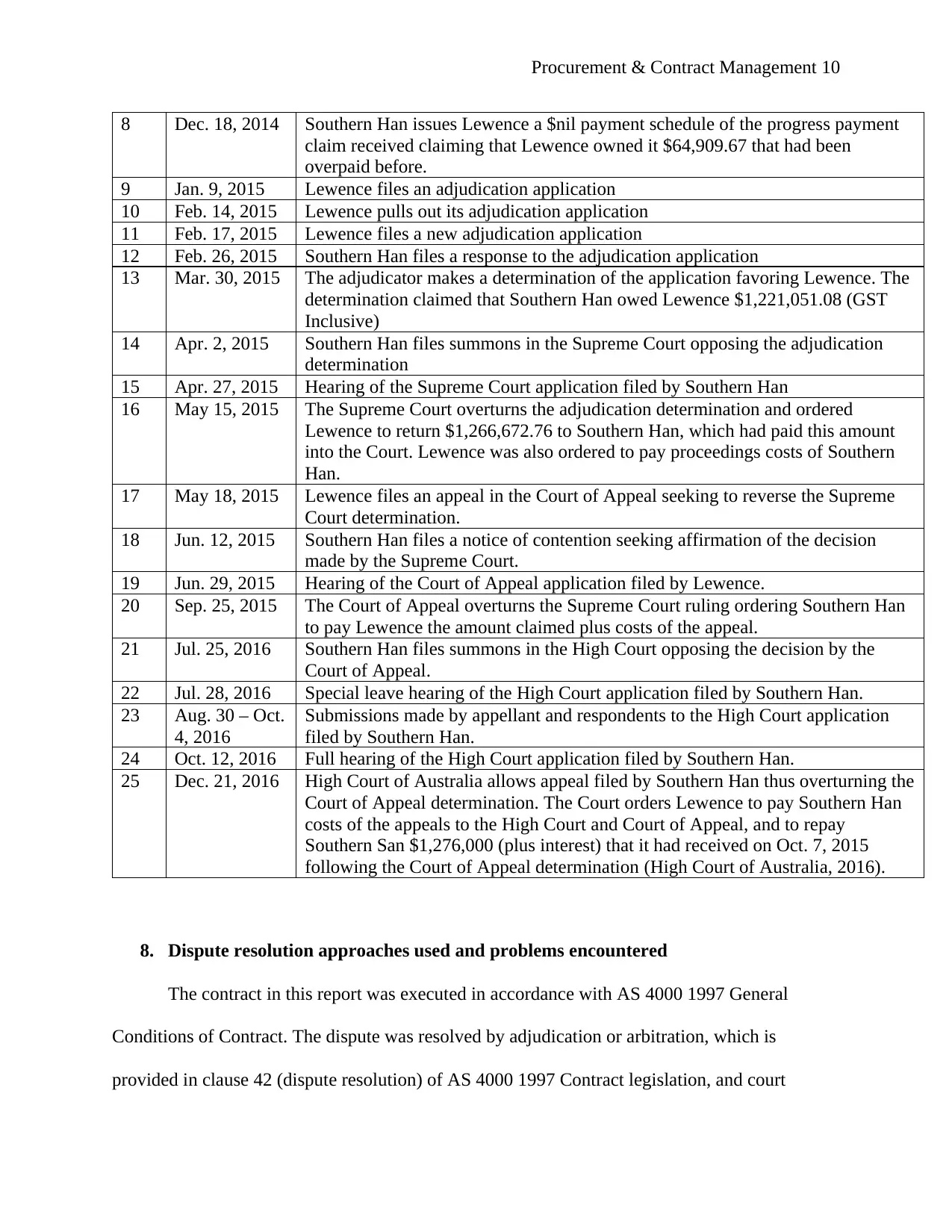
Procurement & Contract Management 10
8 Dec. 18, 2014 Southern Han issues Lewence a $nil payment schedule of the progress payment
claim received claiming that Lewence owned it $64,909.67 that had been
overpaid before.
9 Jan. 9, 2015 Lewence files an adjudication application
10 Feb. 14, 2015 Lewence pulls out its adjudication application
11 Feb. 17, 2015 Lewence files a new adjudication application
12 Feb. 26, 2015 Southern Han files a response to the adjudication application
13 Mar. 30, 2015 The adjudicator makes a determination of the application favoring Lewence. The
determination claimed that Southern Han owed Lewence $1,221,051.08 (GST
Inclusive)
14 Apr. 2, 2015 Southern Han files summons in the Supreme Court opposing the adjudication
determination
15 Apr. 27, 2015 Hearing of the Supreme Court application filed by Southern Han
16 May 15, 2015 The Supreme Court overturns the adjudication determination and ordered
Lewence to return $1,266,672.76 to Southern Han, which had paid this amount
into the Court. Lewence was also ordered to pay proceedings costs of Southern
Han.
17 May 18, 2015 Lewence files an appeal in the Court of Appeal seeking to reverse the Supreme
Court determination.
18 Jun. 12, 2015 Southern Han files a notice of contention seeking affirmation of the decision
made by the Supreme Court.
19 Jun. 29, 2015 Hearing of the Court of Appeal application filed by Lewence.
20 Sep. 25, 2015 The Court of Appeal overturns the Supreme Court ruling ordering Southern Han
to pay Lewence the amount claimed plus costs of the appeal.
21 Jul. 25, 2016 Southern Han files summons in the High Court opposing the decision by the
Court of Appeal.
22 Jul. 28, 2016 Special leave hearing of the High Court application filed by Southern Han.
23 Aug. 30 – Oct.
4, 2016
Submissions made by appellant and respondents to the High Court application
filed by Southern Han.
24 Oct. 12, 2016 Full hearing of the High Court application filed by Southern Han.
25 Dec. 21, 2016 High Court of Australia allows appeal filed by Southern Han thus overturning the
Court of Appeal determination. The Court orders Lewence to pay Southern Han
costs of the appeals to the High Court and Court of Appeal, and to repay
Southern San $1,276,000 (plus interest) that it had received on Oct. 7, 2015
following the Court of Appeal determination (High Court of Australia, 2016).
8. Dispute resolution approaches used and problems encountered
The contract in this report was executed in accordance with AS 4000 1997 General
Conditions of Contract. The dispute was resolved by adjudication or arbitration, which is
provided in clause 42 (dispute resolution) of AS 4000 1997 Contract legislation, and court
8 Dec. 18, 2014 Southern Han issues Lewence a $nil payment schedule of the progress payment
claim received claiming that Lewence owned it $64,909.67 that had been
overpaid before.
9 Jan. 9, 2015 Lewence files an adjudication application
10 Feb. 14, 2015 Lewence pulls out its adjudication application
11 Feb. 17, 2015 Lewence files a new adjudication application
12 Feb. 26, 2015 Southern Han files a response to the adjudication application
13 Mar. 30, 2015 The adjudicator makes a determination of the application favoring Lewence. The
determination claimed that Southern Han owed Lewence $1,221,051.08 (GST
Inclusive)
14 Apr. 2, 2015 Southern Han files summons in the Supreme Court opposing the adjudication
determination
15 Apr. 27, 2015 Hearing of the Supreme Court application filed by Southern Han
16 May 15, 2015 The Supreme Court overturns the adjudication determination and ordered
Lewence to return $1,266,672.76 to Southern Han, which had paid this amount
into the Court. Lewence was also ordered to pay proceedings costs of Southern
Han.
17 May 18, 2015 Lewence files an appeal in the Court of Appeal seeking to reverse the Supreme
Court determination.
18 Jun. 12, 2015 Southern Han files a notice of contention seeking affirmation of the decision
made by the Supreme Court.
19 Jun. 29, 2015 Hearing of the Court of Appeal application filed by Lewence.
20 Sep. 25, 2015 The Court of Appeal overturns the Supreme Court ruling ordering Southern Han
to pay Lewence the amount claimed plus costs of the appeal.
21 Jul. 25, 2016 Southern Han files summons in the High Court opposing the decision by the
Court of Appeal.
22 Jul. 28, 2016 Special leave hearing of the High Court application filed by Southern Han.
23 Aug. 30 – Oct.
4, 2016
Submissions made by appellant and respondents to the High Court application
filed by Southern Han.
24 Oct. 12, 2016 Full hearing of the High Court application filed by Southern Han.
25 Dec. 21, 2016 High Court of Australia allows appeal filed by Southern Han thus overturning the
Court of Appeal determination. The Court orders Lewence to pay Southern Han
costs of the appeals to the High Court and Court of Appeal, and to repay
Southern San $1,276,000 (plus interest) that it had received on Oct. 7, 2015
following the Court of Appeal determination (High Court of Australia, 2016).
8. Dispute resolution approaches used and problems encountered
The contract in this report was executed in accordance with AS 4000 1997 General
Conditions of Contract. The dispute was resolved by adjudication or arbitration, which is
provided in clause 42 (dispute resolution) of AS 4000 1997 Contract legislation, and court
Paraphrase This Document
Need a fresh take? Get an instant paraphrase of this document with our AI Paraphraser
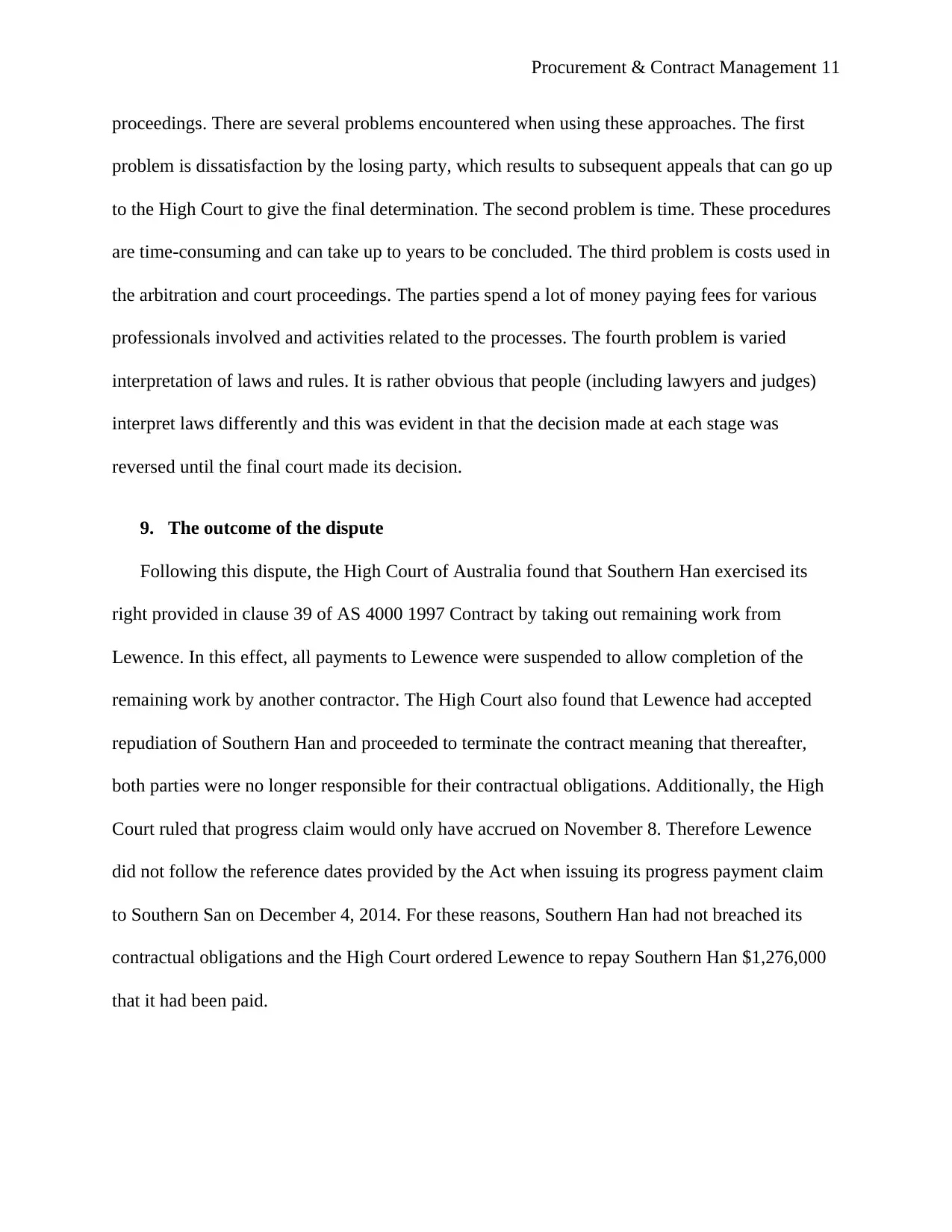
Procurement & Contract Management 11
proceedings. There are several problems encountered when using these approaches. The first
problem is dissatisfaction by the losing party, which results to subsequent appeals that can go up
to the High Court to give the final determination. The second problem is time. These procedures
are time-consuming and can take up to years to be concluded. The third problem is costs used in
the arbitration and court proceedings. The parties spend a lot of money paying fees for various
professionals involved and activities related to the processes. The fourth problem is varied
interpretation of laws and rules. It is rather obvious that people (including lawyers and judges)
interpret laws differently and this was evident in that the decision made at each stage was
reversed until the final court made its decision.
9. The outcome of the dispute
Following this dispute, the High Court of Australia found that Southern Han exercised its
right provided in clause 39 of AS 4000 1997 Contract by taking out remaining work from
Lewence. In this effect, all payments to Lewence were suspended to allow completion of the
remaining work by another contractor. The High Court also found that Lewence had accepted
repudiation of Southern Han and proceeded to terminate the contract meaning that thereafter,
both parties were no longer responsible for their contractual obligations. Additionally, the High
Court ruled that progress claim would only have accrued on November 8. Therefore Lewence
did not follow the reference dates provided by the Act when issuing its progress payment claim
to Southern San on December 4, 2014. For these reasons, Southern Han had not breached its
contractual obligations and the High Court ordered Lewence to repay Southern Han $1,276,000
that it had been paid.
proceedings. There are several problems encountered when using these approaches. The first
problem is dissatisfaction by the losing party, which results to subsequent appeals that can go up
to the High Court to give the final determination. The second problem is time. These procedures
are time-consuming and can take up to years to be concluded. The third problem is costs used in
the arbitration and court proceedings. The parties spend a lot of money paying fees for various
professionals involved and activities related to the processes. The fourth problem is varied
interpretation of laws and rules. It is rather obvious that people (including lawyers and judges)
interpret laws differently and this was evident in that the decision made at each stage was
reversed until the final court made its decision.
9. The outcome of the dispute
Following this dispute, the High Court of Australia found that Southern Han exercised its
right provided in clause 39 of AS 4000 1997 Contract by taking out remaining work from
Lewence. In this effect, all payments to Lewence were suspended to allow completion of the
remaining work by another contractor. The High Court also found that Lewence had accepted
repudiation of Southern Han and proceeded to terminate the contract meaning that thereafter,
both parties were no longer responsible for their contractual obligations. Additionally, the High
Court ruled that progress claim would only have accrued on November 8. Therefore Lewence
did not follow the reference dates provided by the Act when issuing its progress payment claim
to Southern San on December 4, 2014. For these reasons, Southern Han had not breached its
contractual obligations and the High Court ordered Lewence to repay Southern Han $1,276,000
that it had been paid.
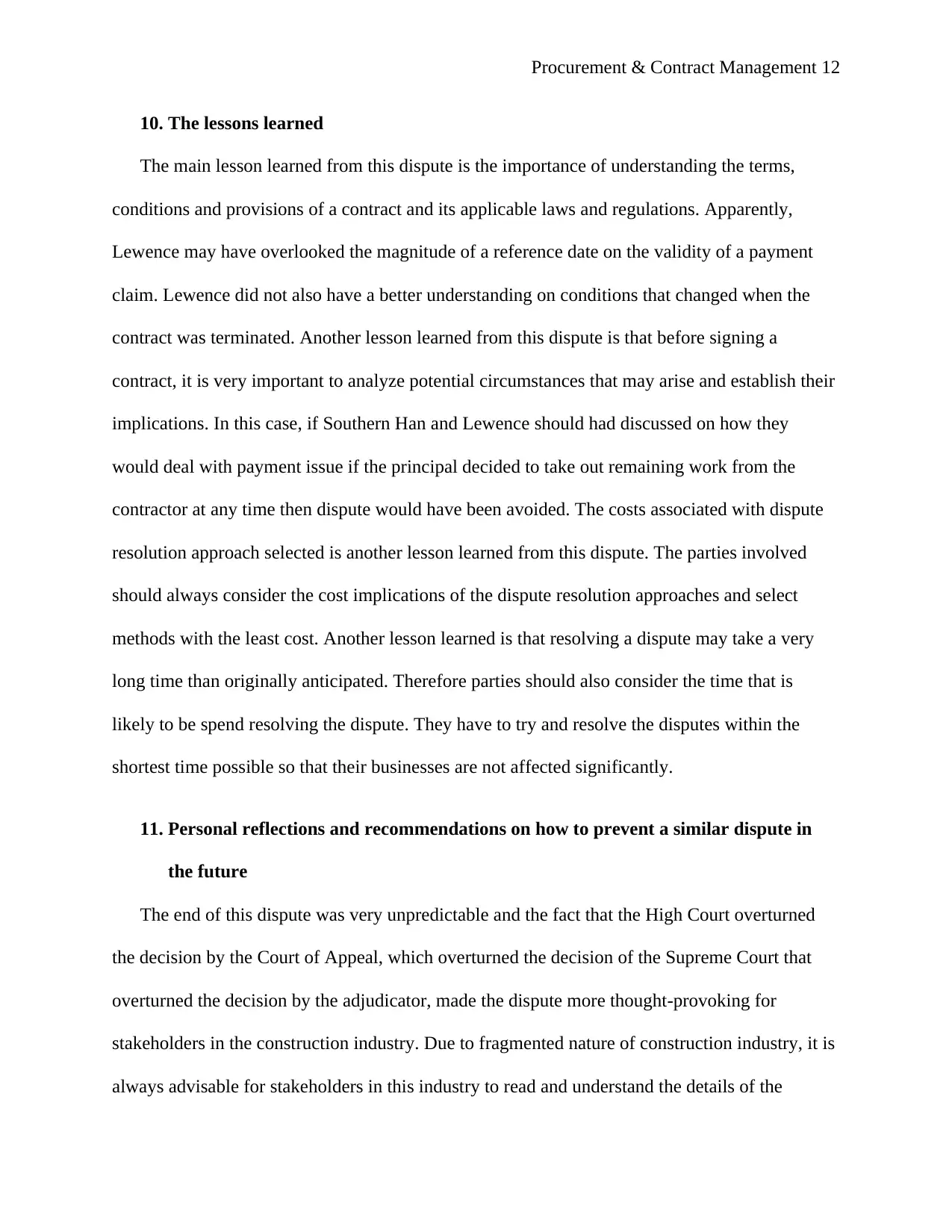
Procurement & Contract Management 12
10. The lessons learned
The main lesson learned from this dispute is the importance of understanding the terms,
conditions and provisions of a contract and its applicable laws and regulations. Apparently,
Lewence may have overlooked the magnitude of a reference date on the validity of a payment
claim. Lewence did not also have a better understanding on conditions that changed when the
contract was terminated. Another lesson learned from this dispute is that before signing a
contract, it is very important to analyze potential circumstances that may arise and establish their
implications. In this case, if Southern Han and Lewence should had discussed on how they
would deal with payment issue if the principal decided to take out remaining work from the
contractor at any time then dispute would have been avoided. The costs associated with dispute
resolution approach selected is another lesson learned from this dispute. The parties involved
should always consider the cost implications of the dispute resolution approaches and select
methods with the least cost. Another lesson learned is that resolving a dispute may take a very
long time than originally anticipated. Therefore parties should also consider the time that is
likely to be spend resolving the dispute. They have to try and resolve the disputes within the
shortest time possible so that their businesses are not affected significantly.
11. Personal reflections and recommendations on how to prevent a similar dispute in
the future
The end of this dispute was very unpredictable and the fact that the High Court overturned
the decision by the Court of Appeal, which overturned the decision of the Supreme Court that
overturned the decision by the adjudicator, made the dispute more thought-provoking for
stakeholders in the construction industry. Due to fragmented nature of construction industry, it is
always advisable for stakeholders in this industry to read and understand the details of the
10. The lessons learned
The main lesson learned from this dispute is the importance of understanding the terms,
conditions and provisions of a contract and its applicable laws and regulations. Apparently,
Lewence may have overlooked the magnitude of a reference date on the validity of a payment
claim. Lewence did not also have a better understanding on conditions that changed when the
contract was terminated. Another lesson learned from this dispute is that before signing a
contract, it is very important to analyze potential circumstances that may arise and establish their
implications. In this case, if Southern Han and Lewence should had discussed on how they
would deal with payment issue if the principal decided to take out remaining work from the
contractor at any time then dispute would have been avoided. The costs associated with dispute
resolution approach selected is another lesson learned from this dispute. The parties involved
should always consider the cost implications of the dispute resolution approaches and select
methods with the least cost. Another lesson learned is that resolving a dispute may take a very
long time than originally anticipated. Therefore parties should also consider the time that is
likely to be spend resolving the dispute. They have to try and resolve the disputes within the
shortest time possible so that their businesses are not affected significantly.
11. Personal reflections and recommendations on how to prevent a similar dispute in
the future
The end of this dispute was very unpredictable and the fact that the High Court overturned
the decision by the Court of Appeal, which overturned the decision of the Supreme Court that
overturned the decision by the adjudicator, made the dispute more thought-provoking for
stakeholders in the construction industry. Due to fragmented nature of construction industry, it is
always advisable for stakeholders in this industry to read and understand the details of the
⊘ This is a preview!⊘
Do you want full access?
Subscribe today to unlock all pages.

Trusted by 1+ million students worldwide
1 out of 16
Related Documents
Your All-in-One AI-Powered Toolkit for Academic Success.
+13062052269
info@desklib.com
Available 24*7 on WhatsApp / Email
![[object Object]](/_next/static/media/star-bottom.7253800d.svg)
Unlock your academic potential
Copyright © 2020–2025 A2Z Services. All Rights Reserved. Developed and managed by ZUCOL.


